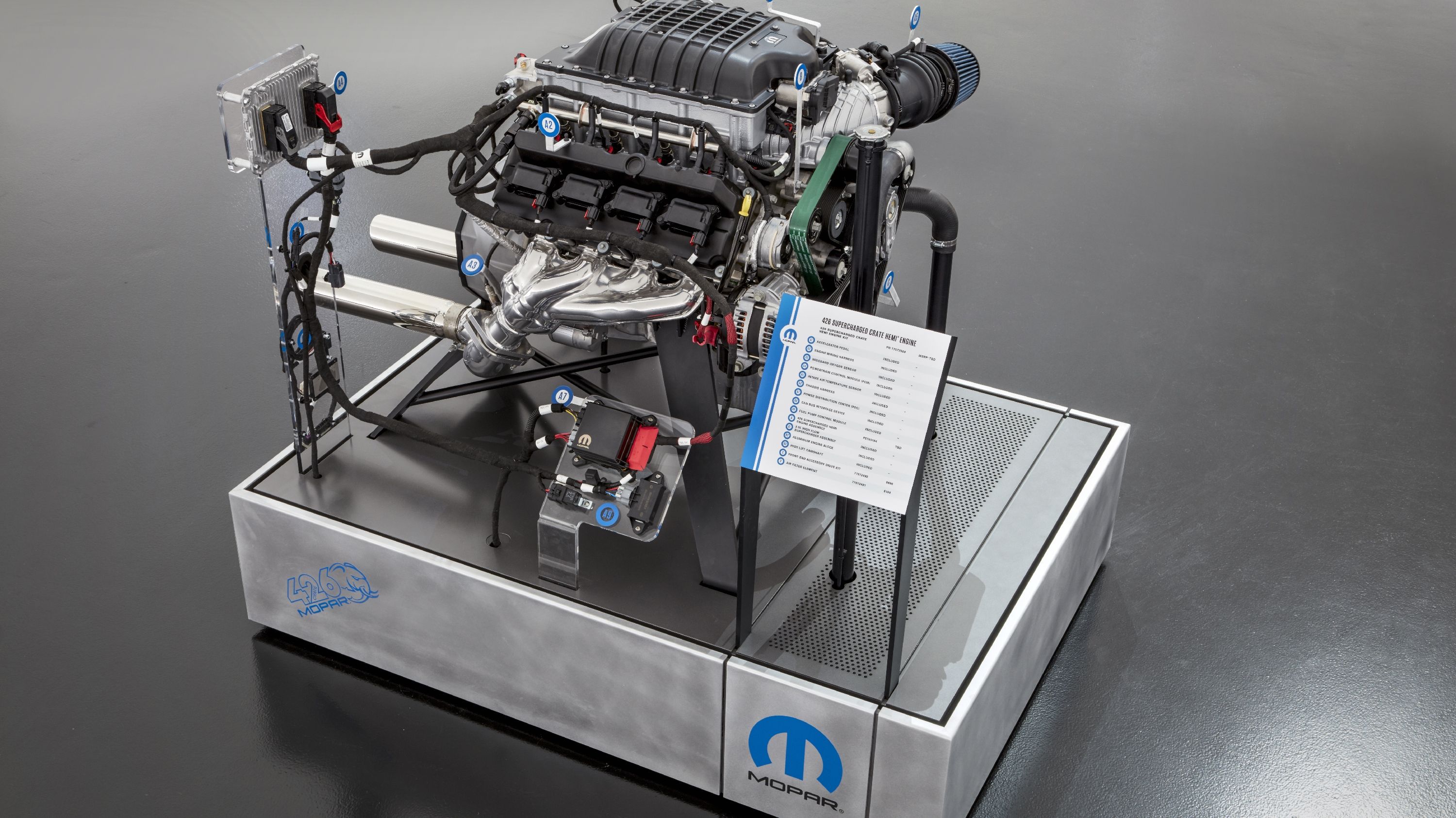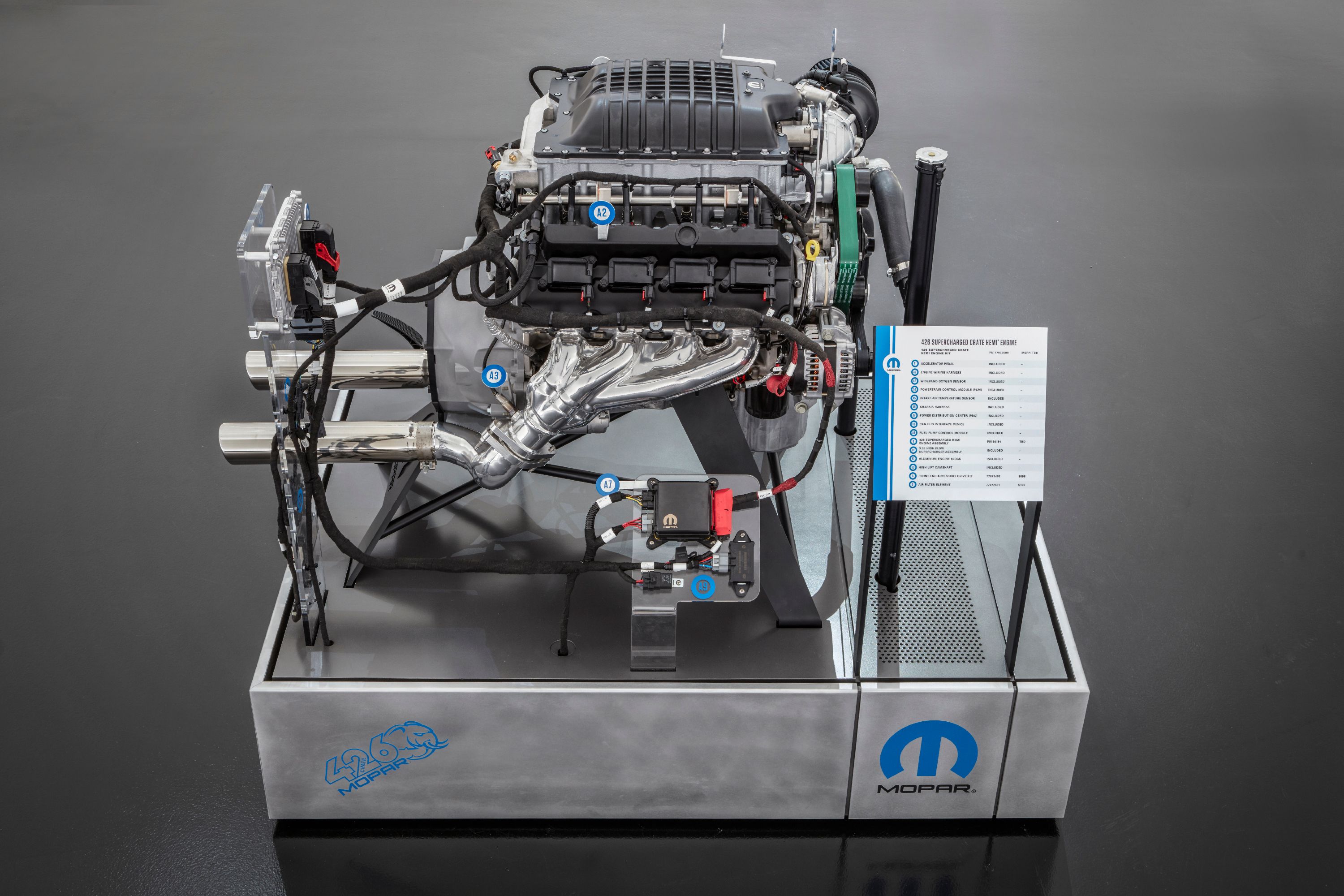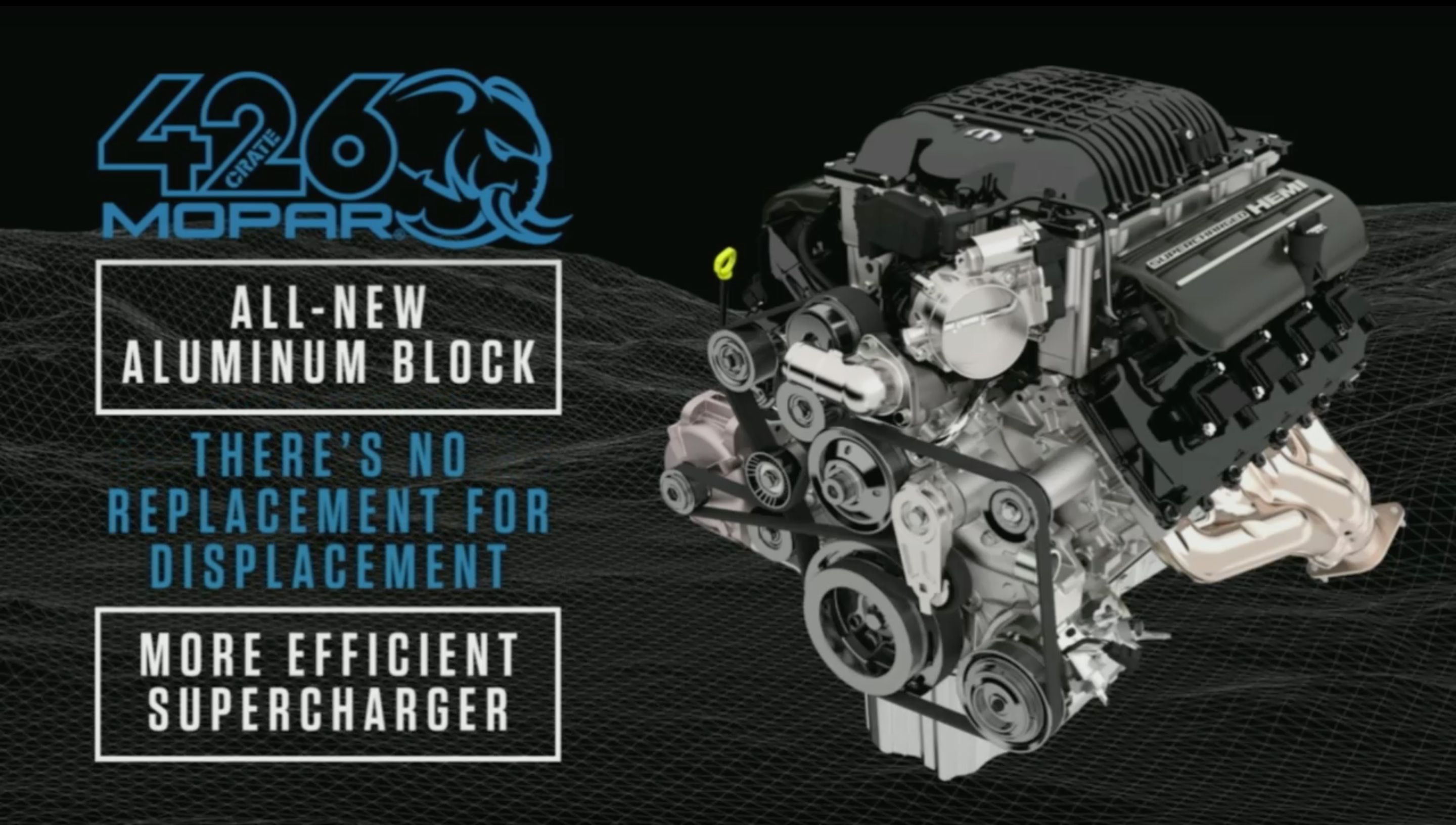Mopar made an enormous splash at SEMA this year, revealing the most powerful crate engine to ever come from an OEM. It’s called the Hellephant, and it’s got enough muscle to outrun just about anything on four wheels. But we wanted to know - what makes it tick, and how does it compare to what’s already out there? What’s more, where exactly will this thing find a home?
First, Some Specs On The Hellephant
Thankfully, the Hellephant most definitely meets both those criteria.
Let’s start with the size. The Hellephant takes after the original 426 Hemi from the ‘60s, and like its predecessor, it too measures in at 426 cubic-inches, or 7.0 liters of displacement for those of you who prefer the metric system over the Imperial system.
The point is this - the Hellephant is huge. Luckily, it also rocking some aluminum goodies, so it’s relatively lightweight, as far as supercharged 7.0-liter V-8’s are concerned, anyway. Interestingly, the Hellephant uses the same block as the Mopar Dodge Challenger Drag Pak racers, which recently had a successful run in the 2018 NHRA Factory Stock Showdown class.
Now for the power part of the equation. Thanks to its new supercharger unit and high-efficiency rotor system, the Hellephant doles out an impressive 1,000 horsepower and 950 pound-feet of torque at the crank, far surpassing any other factory-spec crate engine on the market today.
|
Engine Type |
Third-Gen HEMI V-8 |
|
Displacement |
7.0-Liters, 426 cubic-inches |
|
Composition |
all-aluminum block, Forged Aluminum Pistons, Steel Connecting Rods, Forged Steel Crank, Nodular Iron Camshaft |
|
Horsepower |
1000 hp |
|
Torque |
950 lb-ft |
|
Bore and Stroke |
4.125 x 4.00 Inches |
|
Compression Ratio |
9.5:1 |
|
Valve/Lift Duration |
Intake: 15.9766 mm – 286 deg \ Exhaust: 16.0528 mm – 301 Deg |
|
Intake Valve Size |
54.3 mm |
|
Exhaust Valve Size |
42 mm |
|
Peak RPM |
6,200 |
And stout it is thanks to a slew of beefed-up internals, including forged aluminum pistons, 6.125-inch H-beam forged 4340 steel connecting rods, and a forged steel crank. The stroke is 4.0 inches, while the bore is 4.125 inches, while the compression ratio is set at 9.5:1.
The Hellephant also comes with a modular iron camshaft with a high-lift profile. The intake valves are measured at 54.3 mm, while the exhaust valves are 42 mm.
Redline is set at 6,200 rpm. Of course, premium fuel is required for operation, which is actually pretty impressive if you think about it. We think 1,000 horsepower without race fuel is worthy of celebration, how about you?
Interested customers that order a Hellephant of their own will get just about everything needed for a complete powertrain swap, including the supercharger unit and throttle body, the fuel injectors, the front sump oil pan, the water pump, the flywheel, and the coil packs.
The associated swap kit also comes with the necessary Powertrain Control Module, or PCM, as well as the throttle pedal, power distribution center, ground jumper, 02 sensors, charge air temperature sensors, fuel pump control module, engine wiring harness, chassis harness, and cam bus interface device.
Other standout features include a bevy of parts plucked from the Dodge Challenger SRT Hellcat Redeye and SRT Demon, including the valve covers, valve train, valves, locks, and retainers.
Furthermore, Mopar is offering up a Front End Accessory Drive kit, which tosses in such critical components as the belts, power steering pump, alternator, and pulleys, all of which should make installation go just that much smoother.
How Does It Compare To The Hellcrate?
|
Note: Hellcrate engine pictured here. |
The most obvious comparison we can draw for the Hellephant gets back to what FCA brought to SEMA last year, specifically the Hellcrate.
Regardless, output for the Hellcrate is nothing to sneeze at, topping out at a SRT Hellcat-matching 707 horsepower and 650 pound-feet of torque. Still, that’s 293 ponies 300 pound-feet less than what you get with the Hellephant.
Part of it is down to size, with displacement for the Hellcrate rated at 376 cubic inches, or 6.2 liters, with 103.9 mm (4.09 inches) for the bore and 90.9 mm (3.58 inches) for the stroke.
The block is different as well, with a bottom end made from cast iron and an aluminum head. Inside, you get a forged steel crank, a diamond-like coating for the connecting rods, forged pistons, and a nodular iron camshaft.
|
Note: Dodge Challenger SRT Hellcat pictured here. |
However, as previously mentioned, the valvetrain spec matches that of the Hellephant, with 54.3 mm intake valves and 42 mm exhaust vales. The compression ratio is also set at a Hellephant-matching 9.5:1.
Redline is the same as well, topping out at 6,200-rpm. Premium fuel is required for operation.
Finally, like the Hellephant, the Hellcrate comes with a number of additional kits and parts for installation, including a kit specifically designed for pre-1976 vehicles.
Basically, what you get with the Hellephant is a similar engine architecture as the Hellcrate, just more of it and a lightweight aluminum bottom end to boot.
What Are The Applications?
|
Note: 1968 Dodge Super Charger Concept pictured here. |
With FCA offering the Hellephant as a “plug-and-play” powertrain solution, plus all the requisite info sheets, installations tips, and adapter kits you’d expect from such a product, the question is this - what exactly can you plug it into?
In this particular application, the Hellephant mates to a T-6060 manual six-speed transmission, which was pulled from the Dodge Challenger SRT Hellcat. The Super Charger Concept also features a large hood scoop inspired by the Challenger SRT Demon to help shove more air into the intake.
It’s a dazzling piece of work, but what about those of us wrenching in our garages? Incredibly, Mopar says the engine was configured for use in a street application, or to be exact, the “engine assembly and kit are designed for installation on pre-1976 street and off-road vehicles.” That means if the car in question is exempt from the standard smog rules which govern post-1976 model years, the Hellephant is technically street legal.
You know, because enthusiast.
In addition to custom street cars, this engine will almost certainly find a home with racers as well. The stout build, the insane power, the relatively low-weight all-aluminum construction - sounds like the perfect fit for a modernized 9-second drag machine, don’t you think?
And if the Hellcrate is any indication, that’s exactly where the Hellephant is headed. Like its successor crate engine, the Hellcrate is intended for off-road and pre-1976 vehicles, and so far, we’ve seen it fitted to a number of classic dragsters and street cars.
There’s just one more thing to consider - cost. FCA has yet to divulge exactly how much it’ll run ‘ya to get a Hellephant of your own, but considering the Hellcrate is about $20,000, you can expect this four-figure monster to be even more pricey. So with that in mind, any machine that’s blessed with a Hellephant will need to be quite high-end indeed.
The Hellephant will be available to order in the first quarter of 2019. Until then, post below and tell us your dream application for this wild new crate engine.
Further Reading
Read our full review on the 1968 Dodge Super Charger Concept.
Read our full review on the Dodge Charger SRT Hellcat.
Read our full review on the Dodge Challenger SRT Hellcat.
Read our full review on the standard Dodge Challenger.



